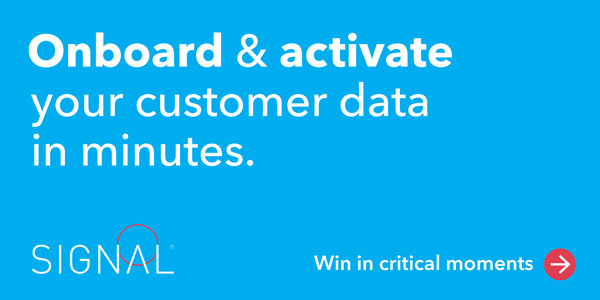This article was produced in partnership with Signal.
Identity continues to attract attention – and investment.
U.S. marketers are responding to surging consumer expectations for more personalized, contextually relevant experiences by spending close to $900 million this year on services and solutions dedicated to solving identity resolution – a sum expected to triple to $2.6 billion in 2022 – according to Winterberry Group. But vendor selection is a challenge.
As a starting point, any robust identity capability will solve for three use cases: person-level resolution, data onboarding and media activation. Many large offline data companies can work with personally identifiable information (PII) data, but lack the means for onboarding and activation. Probabilistic companies and retargeters, on the other hand, can create scale by associating devices to cookies, but do not connect them to real people.
Marketers need both reach and addressability, according to Joe Doran, Chief Identity Officer at Signal, a global onboarding and identity resolution provider.
“Matching and delivering accurate data that is connected to the right people and consumers is still important – critical, even,” Doran said. “But when we measure accuracy, it isn’t just match rates against those specific people. It’s about the ability to accurately identify, reach and engage those individuals across channels with relevant messages in real time.”
Faster, real-time onboarding separates forward-thinking onboarders from first-generation onboarders that require days or weeks to complete device ID and cookie matches to an existing file of customers.
Signal maintains a live connection from brand to customer across multiple buying endpoints. It can onboard and activate millions of customer profiles in minutes in the chosen destinations. This way, when a customer is considering a purchase, brands can respond quickly, and interact with customers at points that are rich with contextual relevance.
“Customers make buying decisions faster than ever now, and you may have only a few hours to act when someone raises their hand to indicate interest in your brand,” according to Signal CEO Mike Sands. “Recently, a multinational automaker told me that the time between customers authenticating with a dealership and purchasing a car has shrunk to four days. Getting ahead of this is the challenge that second-generation onboarding is working to solve.”
In a world of fast decisions and multiple devices, then, the challenge is getting the message in front of the person who visited a brand (or in this case, a dealership) on the same day, if not within the same hour. This requires lining up all of the sources of customer data, and having an onboarding platform that is capable of matching and activating that data instantly.
Second-generation platforms like Signal remove the pain from this process by creating an always-on connection between the brand and the individual that allows a brand to reach that customer immediately – so marketing ad spend can create cascading offers that drive new growth and deeper customer connections.
“Speed really, really matters. A retailer that offers a shopper an incentive that expires within 48 hours can’t wait for a standard onboarder that takes a week to onboard and activate its customer data,” Doran said. “Brands need an onboarder that operates at the speed of their customers — and at the speed of how they interact and deal with those customers.”
This post was syndicated from Ad Exchanger.



More Stories
Scroll Media boosts in-game advertising with new feature
Kiwi filmmaker spotlights media struggles at top global awards
T-Mobile Has Appointed Kristin Harrer As Senior Vice President and Chief Brand Officer